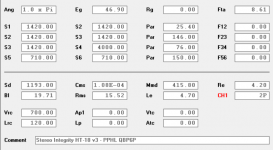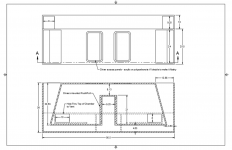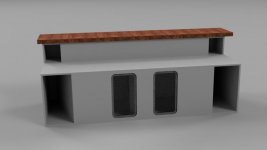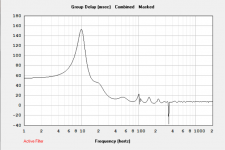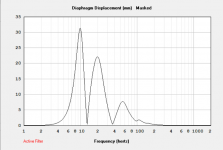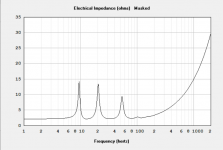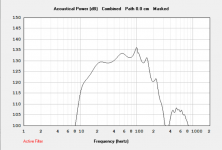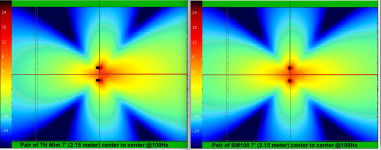No need for labor intensive complicated bass horn. Make a nice opening in the ceiling, cover it with the grill, so it looks like ac vent, and build infinitely buffled sub in above room. You get great bass in two rooms 🙂
Bedrooms above, concrete and dirt below, no adjoining rooms that I can use for IB.
I'd love to see a giant architectural feature on a wall used as a bass horn, but that's not going to work for my space. I have up to about 50 cubic feet of bartop structure behind the front row of seats to work with.
I'd appreciate any comments or criticism regarding my sealed horn designs. It seems to me that this should work pretty well. I could get better extension under 20hz with the back loaded designs (BR or TQWT), but at the expense of some headroom above 20, excursion control below Fb, and the behavior with phase, impulse response and group delay. Compared to a sealed direct radiator, I gain quite a bit of headroom, an acoustic low-pass filter to mitigate some distortion and noise, and the drivers are protected from their natural predators like curious dogs and children.
I'd love to see a giant architectural feature on a wall used as a bass horn, but that's not going to work for my space. I have up to about 50 cubic feet of bartop structure behind the front row of seats to work with.
I'd appreciate any comments or criticism regarding my sealed horn designs. It seems to me that this should work pretty well. I could get better extension under 20hz with the back loaded designs (BR or TQWT), but at the expense of some headroom above 20, excursion control below Fb, and the behavior with phase, impulse response and group delay. Compared to a sealed direct radiator, I gain quite a bit of headroom, an acoustic low-pass filter to mitigate some distortion and noise, and the drivers are protected from their natural predators like curious dogs and children.
OP said:
"Room Dimensions:
The room measures about 20'x25', with a bathroom built out of one of the corners,"
If the bathroom is large enough, there is your IB space.
"Room Dimensions:
The room measures about 20'x25', with a bathroom built out of one of the corners,"
If the bathroom is large enough, there is your IB space.
That would be technically feasible, but the space above the drop ceilings in the main room and the bathroom are open to each other, so it would take a major construction project to get it working well. The bathroom is also in the farthest corner from the main seats, and I don't want to produce quite that much bass in the bathroom, since it and the theater are sometimes in use simultaneously.
I'd appreciate any comments or criticism regarding my sealed horn designs.
Nothing wrong with using a sealed horn = front loaded horn [FLH], it's what the pioneers began with combined with OB floor loaded woofer arrays. 😉
HR has proven to be an accurate enough program, so if its size/performance meets all your goals.........
http://www.audioheritage.org/images/misc/we/wide-range.jpg
Thanks GM, although what's unusual about the design I had modeled is that, with a rather large rear chamber and a horn tuned significantly higher than driver Fs, the model behaves a bit more like a 4th order bandpass than a proper FLH. I just haven't seen any documented designs with that architecture, so wondered if I was missing something.
That said, I have since come up with a design that I like better. It's the same basic thing, an undersized "W-Bin" shaped FLH, but with a much larger, and vented, rear chamber. Or, a horn-loaded quasi-6th order bandpass, with the rear chamber tuned to about 12hz. That provides quite a lot more headroom down low, at the expense of somewhat higher group delay, which is still actually pretty reasonable. The horn on the front seems to cure the peak at resonance, and the dip above it, that I've run into trying to tune any other vented design that low. I can't say I know why that is, but I like how it models.
That said, I have since come up with a design that I like better. It's the same basic thing, an undersized "W-Bin" shaped FLH, but with a much larger, and vented, rear chamber. Or, a horn-loaded quasi-6th order bandpass, with the rear chamber tuned to about 12hz. That provides quite a lot more headroom down low, at the expense of somewhat higher group delay, which is still actually pretty reasonable. The horn on the front seems to cure the peak at resonance, and the dip above it, that I've run into trying to tune any other vented design that low. I can't say I know why that is, but I like how it models.
Here's what I have so far, modeled as a compound horn with a rear chamber, which I believe will become the final design. It's still going to need a few tweaks to get the Hornresp model and the physical design to match. Bracing is not shown in the drawing, of course. The Hornresp graphs are shown with a 4th order high pass at 10hz.
From what I understand, it's a quasi-6th order bandpass, functionally very similar to John Ricci's "Skhorn" design, but obviously much larger and tuned lower. The port and horn mouths are symmetrical and spaced about 7ft apart, which I suspect might have some benefits for in-room response, though there may be other effects that wouldn't appear in the model. If the Hornresp SPL predictions are anywhere near accurate, this thing is going to have plenty of headroom for anything I'll throw at it.
Two errors to correct from my previous post: tuning frequency is 13hz, not 12; and group delay is pretty reasonable *above 20hz*. I can't imagine group delay is going to be a real issue below that.
From what I understand, it's a quasi-6th order bandpass, functionally very similar to John Ricci's "Skhorn" design, but obviously much larger and tuned lower. The port and horn mouths are symmetrical and spaced about 7ft apart, which I suspect might have some benefits for in-room response, though there may be other effects that wouldn't appear in the model. If the Hornresp SPL predictions are anywhere near accurate, this thing is going to have plenty of headroom for anything I'll throw at it.
Two errors to correct from my previous post: tuning frequency is 13hz, not 12; and group delay is pretty reasonable *above 20hz*. I can't imagine group delay is going to be a real issue below that.
Attachments
Thanks GM
You're welcome!
A FLH is technically a 4th order BP. 😉 There's been some mid-bass prosound ones, though don't know about recent decades. Ditto your 6th order, though of course not tuned this low.
From what I understand, it's a quasi-6th order bandpass.
I can't imagine group delay is going to be a real issue below that.
Looks like parallel 6th order to me. 😉
Well, at 1/4 WL they sum as one, so ~13543/4/84 = ~40 Hz.
Indeed! In the [later documented] 140s is the highest sustains I've experienced indoors and exited to the normally near soundproof vestibule to finish listening to the finale at still loud levels with the doors just barely cracked open, so combined with high VLF pressure, it could be way too much for me even in my prime when being in a closed 10 x10 x 8 ft bedroom with a cousin going nuts on a full drum kit had me gritting my teeth.
BTW, will a drop ceiling handle the VLF? Inquiring minds want to know. 😉
Well sure, technically, but a "typical" FLH and a "typical" BP4 have different characteristic response shapes. What I had come up with looks a little more like a typical BP4 with its high shoulder instead of the FLH's series of small peaks, except that the first peak from the horn's response is down in the middle of the passband, and the next couple of horn peaks stretch out the top of the passband to a higher frequency than I'd get with a similarly tuned single-reflex BP. The 6th order version has the same kind of thing going on, but with port gain.A FLH is technically a 4th order BP.
Sure, the horn mouths sum at 1/4 WL, but what do they do when they're not summing? I guess I could draw some conclusions by modelling half of the enclosure.
The drop ceiling tiles are the fairly heavy mineral fiber type. I haven't noticed them reacting to sound pressure yet. Will that remain the case when the sub is putting out 125db at 16hz? Uh, no, I don't think it will. At reasonable volumes it might not be an issue. We'll see.
Here’s something possibly ? It’s parallel then joined at the last segment for exit. See what you think? Even if it doesn’t interest you if you have any ideas or feedback on it, totally appreciate it. Ive been tossing a lot of things in this lately , big small and in between drivers as well.
Attachments
Eh.......my mentors were the pioneers that created a rather mundane 4th order BP driver and used an exponential horn vent + phase plug to make it a FLH, ditto yours with just a horn shaped vent terminus, so for me it's a 'six of one, half a dozen of the other' description wise for me.
Still summing/comb filtering with each other beginning with a null at Fb, peaks at the 1/2 octave points till it inverts at the 3rd harmonic where the big notch normally occurs [~13*2^3 = ~104 Hz] with peaks/nulls flipping in sequence, so easiest to see in the displacement, delay plots.
Re group delay, it wasn't until I joined the WWW audio forums that I was exposed to the term, but believed it wasn't an issue with my various 'critically' damped BRs, TLs, etc., though when decent simming tools came along, found out that none I simmed ever exceeded ~35 ms/~35 Hz with ~20-25 Hz tuning, hence my empirical guideline to not exceed in the LF FWIW/YMMV, so you're 'golden' AFAIK/TTBOMK. 😉
Still summing/comb filtering with each other beginning with a null at Fb, peaks at the 1/2 octave points till it inverts at the 3rd harmonic where the big notch normally occurs [~13*2^3 = ~104 Hz] with peaks/nulls flipping in sequence, so easiest to see in the displacement, delay plots.
Re group delay, it wasn't until I joined the WWW audio forums that I was exposed to the term, but believed it wasn't an issue with my various 'critically' damped BRs, TLs, etc., though when decent simming tools came along, found out that none I simmed ever exceeded ~35 ms/~35 Hz with ~20-25 Hz tuning, hence my empirical guideline to not exceed in the LF FWIW/YMMV, so you're 'golden' AFAIK/TTBOMK. 😉
Here’s something possibly ?
Again, please export/attach the .txt file, so can DL, run in HR.
TIA
A big thanks for the input GM, this has been exceedingly helpful.
I see your point, it is still a FLH and behaves as such, even if the really distinctive horn characteristics don't dominate the overall response. What was making me unsure of these designs was simply that they don't quite adhere to the commonly cited rules of thumb for either horns or reflex BP boxes. They are quite a lot different from the FLH designs that are popular for HT use, like the THT and the F20, which use much longer horn paths. Then with the vented version it occurred to me that I had inadvertently arrived at a variant of Ricci's Skhorn design over at data-bass, just twice the size and an octave lower, which seems like a reasonable thing to build.
Booger, I fiddled with that paraflex design a little. That big null and weird delay behavior around 100hz just doesn't want to go away, and that's a bit close to the crossover frequency for my comfort. It looks like it might do some things right if you can low pass it low enough to keep it out of the twilight zone there.
I see your point, it is still a FLH and behaves as such, even if the really distinctive horn characteristics don't dominate the overall response. What was making me unsure of these designs was simply that they don't quite adhere to the commonly cited rules of thumb for either horns or reflex BP boxes. They are quite a lot different from the FLH designs that are popular for HT use, like the THT and the F20, which use much longer horn paths. Then with the vented version it occurred to me that I had inadvertently arrived at a variant of Ricci's Skhorn design over at data-bass, just twice the size and an octave lower, which seems like a reasonable thing to build.
Booger, I fiddled with that paraflex design a little. That big null and weird delay behavior around 100hz just doesn't want to go away, and that's a bit close to the crossover frequency for my comfort. It looks like it might do some things right if you can low pass it low enough to keep it out of the twilight zone there.
You're welcome!
Understood, an optimized compression horn is tuned to the mean of its low corner as defined by its terminus [Sm] + any boundary loading and its HF corner by its effective throat area [St], whereas yours is only compression loaded via its low pass filter chamber the vent is attached to.
Understood, an optimized compression horn is tuned to the mean of its low corner as defined by its terminus [Sm] + any boundary loading and its HF corner by its effective throat area [St], whereas yours is only compression loaded via its low pass filter chamber the vent is attached to.
Past 1/4 wavelength, 45 degrees of phase difference, summation drops from +6db to a theoretical complete cancellation at 180 degrees.Sure, the horn mouths sum at 1/4 WL, but what do they do when they're not summing?
The drop ceiling tiles are the fairly heavy mineral fiber type. I haven't noticed them reacting to sound pressure yet. Will that remain the case when the sub is putting out 125db at 16hz? Uh, no, I don't think it will.
The center to center distance between the horn mouths is 7' (2.15meters), the wavelength of 100 Hz is 11.3'.
In free space, at 100Hz, that spacing would result in a "X" shaped reduced output level pattern as can be seen in the simulations below.
The left hand simulation uses a pair of small tapped horns that have a bit of pattern control at 100Hz, the nulls are deeper behind.
The right hand simulation uses a more "omni" cabinet, the nulls are symmetrical.
Room modes will dominate the frequency response, so the actual response may look nothing like the simulations.
Your drop ceiling will make for more room variations as they transition from a semi-absorptive barrier to a passive radiator.
I'd expect a shower of mineral dust from sustained frequencies in various locations well before reaching 125dB at one meter
 !
!Art
Attachments
they spend their time wreaking havoc at several frequencies and phase angles in the sound field of interest...Sure, the horn mouths sum at 1/4 WL, but what do they do when they're not summing? .
Past 1/4 wavelength, 45 degrees of phase difference, summation drops from +6db to a theoretical complete cancellation at 180 degrees.
The center to center distance between the horn mouths is 7' (2.15meters), the wavelength of 100 Hz is 11.3'.
In free space, at 100Hz, that spacing would result in a "X" shaped reduced output level pattern as can be seen in the simulations below.
The left hand simulation uses a pair of small tapped horns that have a bit of pattern control at 100Hz, the nulls are deeper behind.
The right hand simulation uses a more "omni" cabinet, the nulls are symmetrical.
Room modes will dominate the frequency response, so the actual response may look nothing like the simulations.
Your drop ceiling will make for more room variations as they transition from a semi-absorptive barrier to a passive radiator.
I'd expect a shower of mineral dust from sustained frequencies in various locations well before reaching 125dB at one meter!
Art
This kind of info is like verbal gold .!!
It’s so amazing how some of these things were just looking at the red zone on the cardioid inverse shape playing with other things and other areas that create other shapes of that nature like three or four of the kidney shaped versions were not there’s so much more to this game yet to be played. Taking ideas and things from all of you guys and mixing them together and playing with him at the Keystone the Roar with /a restricted exit like (not exactly) the Keystone exit to the Paraflex that doesn’t even look like a PA version of that but the same version with pioe in the ideas in another direction and the results of these things thanks to this place and getting ideas from this place and all of you people with all these awesome explanations and examples is ridiculously valuable
Taking ideas and things from all of you guys and mixing them together and playing with him at the Keystone the drawer with the Keystone exit to the Paraflex that doesn’t even look like a PO Box or to everybody is using the same ideas in another direction and the results of these things thanks to this place and getting ideas from this place and all of you people with all these awesome explanations and examples is priceless
Edit: LOL? This stupid dictating program doubles up what I was told it to say, if I try to make a couple corrections it just gets worse… oh well… fawk tech nology , spellcheck needs a spellcheck and grammar check is on strike again !! Haaa
Last edited:
Past 1/4 wavelength, 45 degrees of phase difference, summation drops from +6db to a theoretical complete cancellation at 180 degrees.
The center to center distance between the horn mouths is 7' (2.15meters), the wavelength of 100 Hz is 11.3'.
In free space, at 100Hz, that spacing would result in a "X" shaped reduced output level pattern as can be seen in the simulations below.
The left hand simulation uses a pair of small tapped horns that have a bit of pattern control at 100Hz, the nulls are deeper behind.
The right hand simulation uses a more "omni" cabinet, the nulls are symmetrical.
Room modes will dominate the frequency response, so the actual response may look nothing like the simulations.
Your drop ceiling will make for more room variations as they transition from a semi-absorptive barrier to a passive radiator.
I'd expect a shower of mineral dust from sustained frequencies in various locations well before reaching 125dB at one meter!
Art
This kind of info is like verbal gold .!!
It’s so amazing how some of these things were just looking at the red zone on the cardioid inverse shape playing with other things and other areas that create other shapes of that nature beauty to three or four of the kidney shaped versions were not there’s so much more to this game yet to be played. Taking ideas and things from all of you guys and mixing them together and playing with him at the Keystone the drawer with the Keystone exit to the Paraflex that doesn’t even look like a PO Box or to everybody is using the same ideas in another direction and the results of these things thanks to this place and getting ideas from this place and all of you people with all these awesome explanations and examples is ridiculously valuable
Taking ideas and things from all of you guys and mixing them together and playing with him at the Keystone the drawer with the Keystone exit to the Paraflex that doesn’t even look like a PO Box or to everybody is using the same ideas in another direction and the results of these things thanks to this place and getting ideas from this place and all of you people with all these awesome explanations and examples is priceless
- Home
- Loudspeakers
- Subwoofers
- Which type of huge enclosure?
